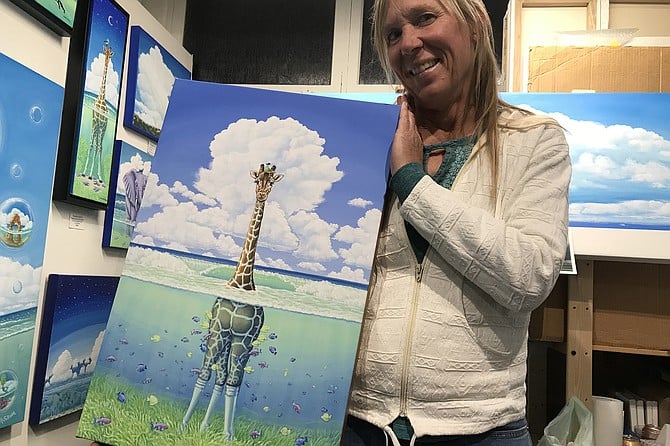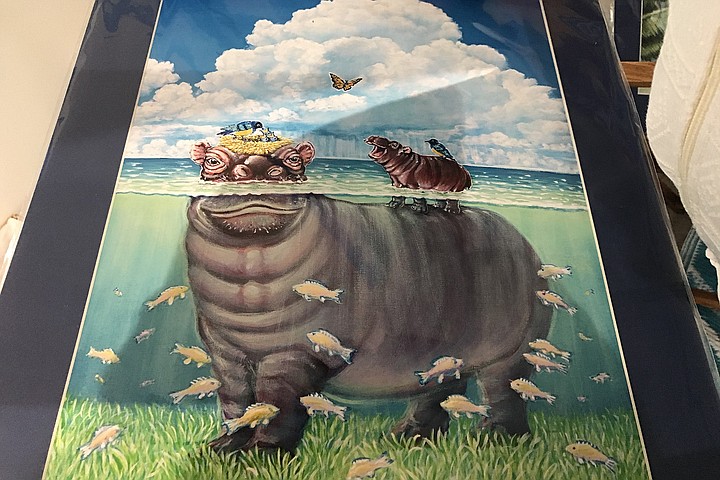 Facebook
Facebook
 X
X
 Instagram
Instagram
 TikTok
TikTok
 Youtube
Youtube

It’s one of those evenings. I’m in The Studio in Hillcrest with my friend Eric. He’s introducing me to his friend, the artist Elisabeth Sullivan. And straightaway, I’m mesmerized by this painting of hers. It’s of a giraffe, up to his neck in water. The first thing I think of is rising seas, climate change — and yet the giraffe seems happy. There’s nothing angry about this art. In fact, even when it’s depicting land animals in water, it seems dreamy, not nightmarish.
The one thing missing from all Elisabeth Sullivan’s paintings is human beings. “I don’t paint people. I’m angry at them, at us, for letting the world down, for not protecting this beautiful blue dot,” she says. “But I don’t paint angry pictures. I don’t paint to make a point. I just paint what is beautiful.” Which makes her pictures all the more poignant. She has turned more and more to her “over-under” pictures, where, as if looking at the world through a half-submerged snorkeling mask, she shows different fantasy portraits of life above water and below: birds nesting, penguins on small floating chunks of ice, elephants treading deserts, half-submerged monumental rock arches, cacti sprouting through water, and maybe the most famous of all, this giraffe among breaking rollers, with fish swimming around his long legs.

It’s whimsical, but you can’t help thinking it feels like some sort of requiem for the life we’re currently throttling from Mother Earth. Still, Elisabeth denies any politics in her paintings. “My art is an escape world for me,” she says. “To escape bad feelings and trauma — and growing up, I had my share of that — so other people who are healing from such things often feel connected.”
Tonight, for instance. The artists of The Studio at Fourth and University are holding an open house. A 24-year-old named Audrey comes in. “This art saved me,” she says. “These beautiful animals and birds saved me. I came in here and I’d been having the worst year of my life. I’d been hospitalized twice, and it’s just been a really shitty time for me, bouncing around from home to home, whatever. It’s been chaotic. I’ve been massively suicidal. I tried to take my life multiple times this year. So to be able to have this art, an immediate portal to that [beautiful world], it’s amazing! I bought this bubble picture last time, and it is freaking magical to me. Especially when I’m not having a good day. You just look at it and immediately feel those restorative emotions. There’s not a price on that.”
Elisabeth feels a little overwhelmed by the praise. “You feel you want to help people, but my only gift is my art. I’m just painting pretty pictures. And yet, when I realize it can have this sort of effect…” Both of them are near tears. “Most people think choosing a life of art is narcissistic. That I’m just painting, and not going out and say, feeding needy children, and donating my time and money to everybody on the planet. But then come moments of connection like this. They are special, they keep me going, because being an artist is not an easy job.”
Now she turns to another group. They want to know if the giraffe is okay.


It’s one of those evenings. I’m in The Studio in Hillcrest with my friend Eric. He’s introducing me to his friend, the artist Elisabeth Sullivan. And straightaway, I’m mesmerized by this painting of hers. It’s of a giraffe, up to his neck in water. The first thing I think of is rising seas, climate change — and yet the giraffe seems happy. There’s nothing angry about this art. In fact, even when it’s depicting land animals in water, it seems dreamy, not nightmarish.
The one thing missing from all Elisabeth Sullivan’s paintings is human beings. “I don’t paint people. I’m angry at them, at us, for letting the world down, for not protecting this beautiful blue dot,” she says. “But I don’t paint angry pictures. I don’t paint to make a point. I just paint what is beautiful.” Which makes her pictures all the more poignant. She has turned more and more to her “over-under” pictures, where, as if looking at the world through a half-submerged snorkeling mask, she shows different fantasy portraits of life above water and below: birds nesting, penguins on small floating chunks of ice, elephants treading deserts, half-submerged monumental rock arches, cacti sprouting through water, and maybe the most famous of all, this giraffe among breaking rollers, with fish swimming around his long legs.

It’s whimsical, but you can’t help thinking it feels like some sort of requiem for the life we’re currently throttling from Mother Earth. Still, Elisabeth denies any politics in her paintings. “My art is an escape world for me,” she says. “To escape bad feelings and trauma — and growing up, I had my share of that — so other people who are healing from such things often feel connected.”
Tonight, for instance. The artists of The Studio at Fourth and University are holding an open house. A 24-year-old named Audrey comes in. “This art saved me,” she says. “These beautiful animals and birds saved me. I came in here and I’d been having the worst year of my life. I’d been hospitalized twice, and it’s just been a really shitty time for me, bouncing around from home to home, whatever. It’s been chaotic. I’ve been massively suicidal. I tried to take my life multiple times this year. So to be able to have this art, an immediate portal to that [beautiful world], it’s amazing! I bought this bubble picture last time, and it is freaking magical to me. Especially when I’m not having a good day. You just look at it and immediately feel those restorative emotions. There’s not a price on that.”
Elisabeth feels a little overwhelmed by the praise. “You feel you want to help people, but my only gift is my art. I’m just painting pretty pictures. And yet, when I realize it can have this sort of effect…” Both of them are near tears. “Most people think choosing a life of art is narcissistic. That I’m just painting, and not going out and say, feeding needy children, and donating my time and money to everybody on the planet. But then come moments of connection like this. They are special, they keep me going, because being an artist is not an easy job.”
Now she turns to another group. They want to know if the giraffe is okay.
Comments